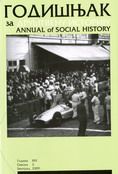Епископ Анђело Фазоло и презвитер Трифун Скити
Bishop Angelo Fasolo and priest Tryphon de Sciti
Author(s): Katarina MitrovićSubject(s): History
Published by: Udruženje za društvenu istoriju
Keywords: Kotor bishopric; bourgeoisy; nobility; Republic of Venice
Summary/Abstract: The political instability, the town economic power decline and the growing objective threat of the Turkish attacks reflected on, among the other things, the church circumstances in the bishoprics under the Venetian authority on the east Adriatic coast in the second half of the 15th century. The general insecurity led to a more pronounced conflict between the priests of the bourgeois origin and their colleagues belonging to the orders of the town nobility. At the time of the arrival of the bishop AngeloFasolo in Kotor (1457-1459) the representatives of the bourgeois class had already for several times shown the determination endeavouring to achieve a greater influence on the church circumstances in their town. The typical representatives of the plebs class in the orders of the Kotor priests were Jovan Paltasic (Johannes Palthasich) andAntonijeDrusko (Antonius de Drusco), who gained in the middle of the 15th century in the bishopric and with the Venetian authorities a vaster influence than any other aristocrat priest. By the education, beliefs and background, they were close to Fasolo, the bishop and the learned lawyer. Fasolo himself came from a respected bourgeois family from the town on the lagoons. On the other hand, the Kotor nobility with all their might did their best to preserve their previous positions in all the segments of the political and social activities. The Kotor nobility priests gathered around the cathedral chapter demonstrated an ultimate conservativeness, especially when it came down to collecting the incomes from certain churches, thus actually preventing the young plebs priests from getting their own parishes. Being supported by the Venetian duke in Kotor and trying to do that, they occasionally reached for some illegal means to achieve their goal. Therefore, in the clash between bishop Angelo Fasolo and priest Tryphon de Sciti regarding the collecting the rent from the properties owned by the Church of Saint Marco, which at one point led to the physical assault of the bishop Fasolo on the priest Sciti, apart from the personal, some distinct social reasons should be looked for.
Journal: Godišnjak za društvenu istoriju
- Issue Year: XVI/2009
- Issue No: 3
- Page Range: 43-56
- Page Count: 14
- Language: Serbian

